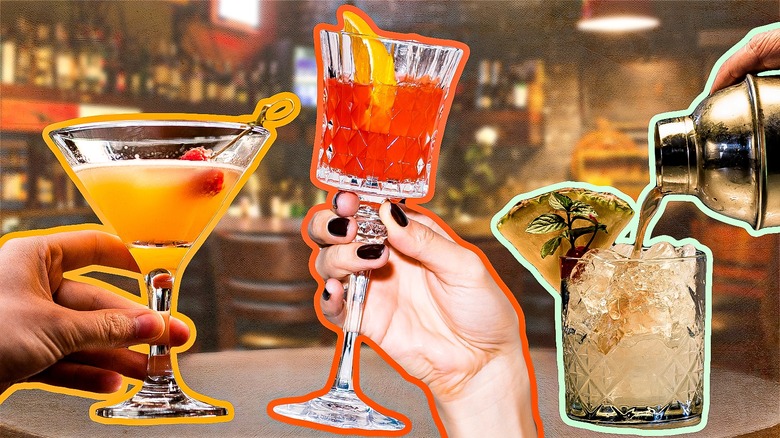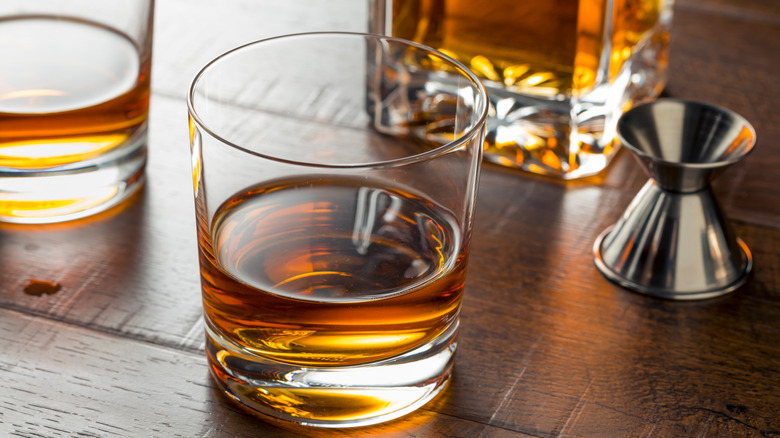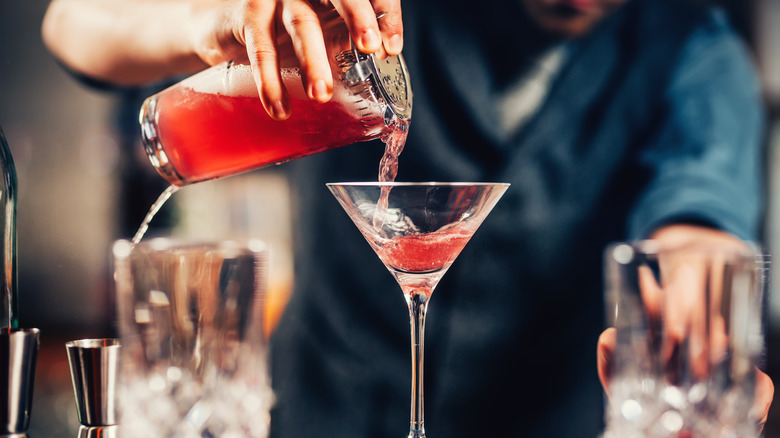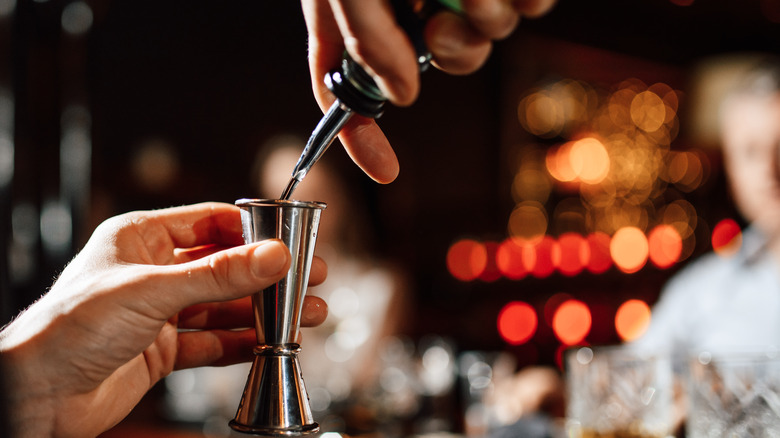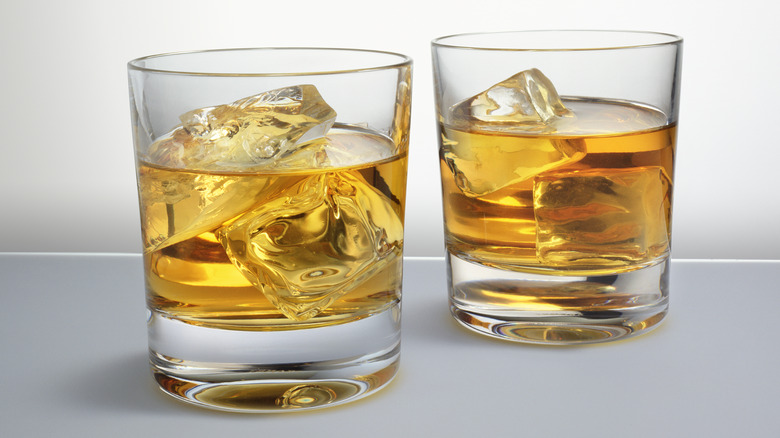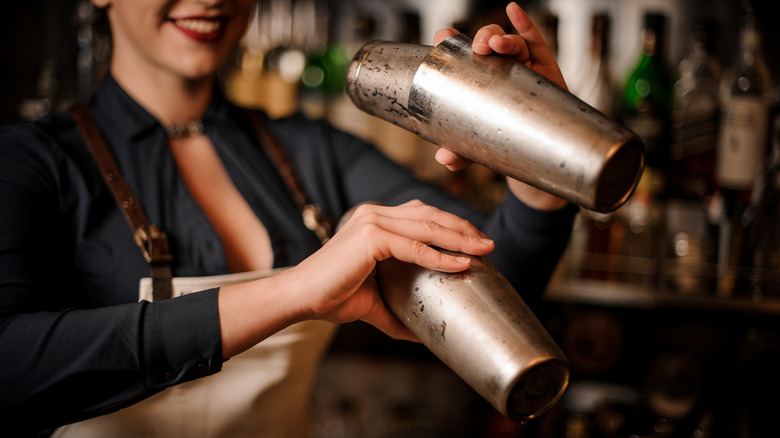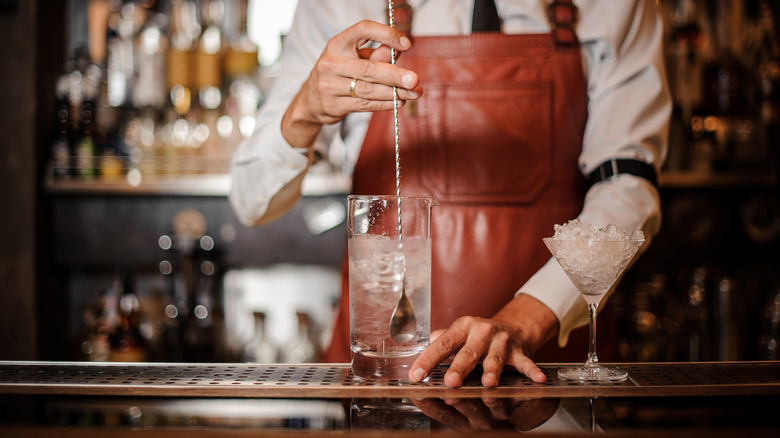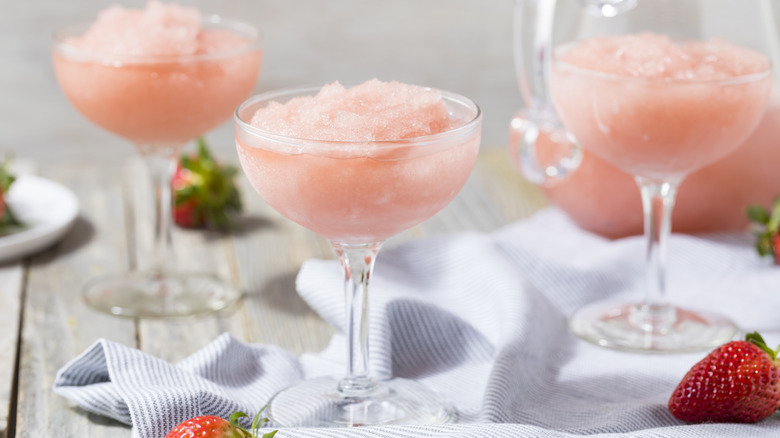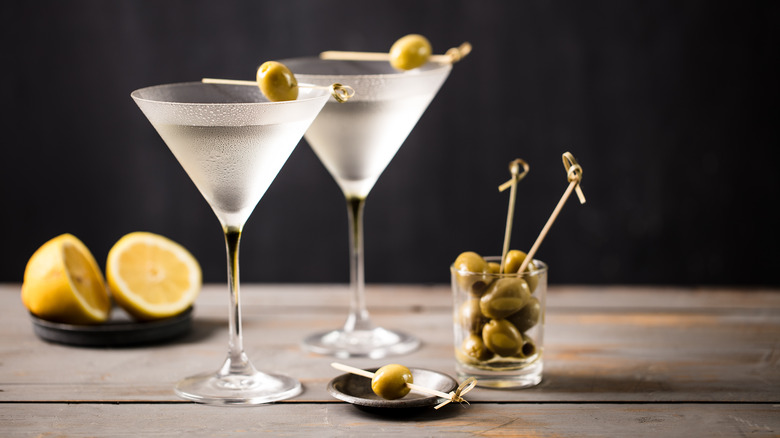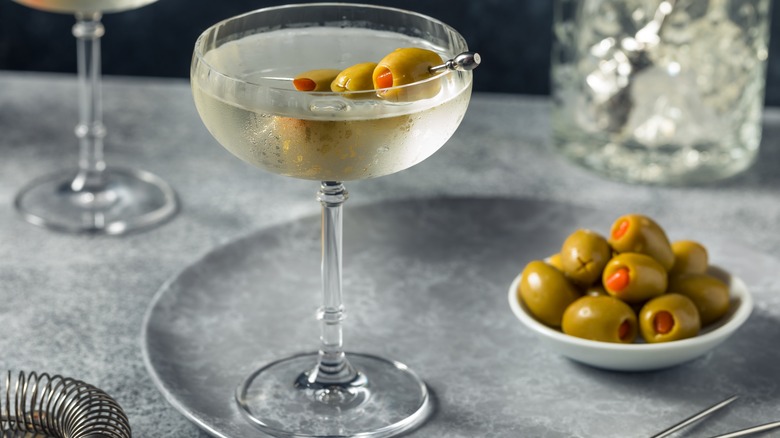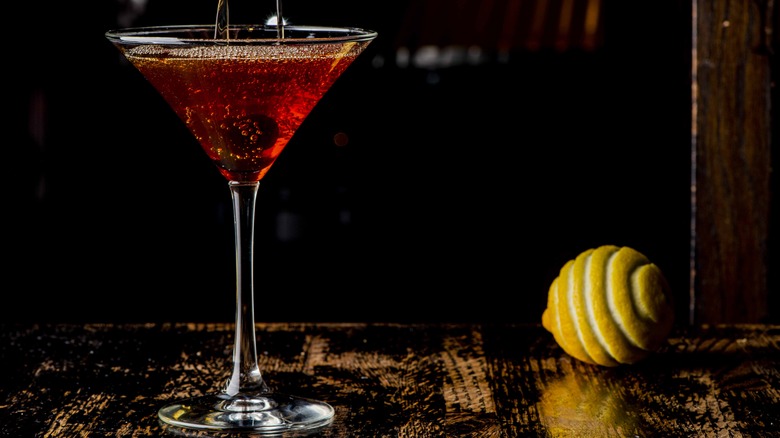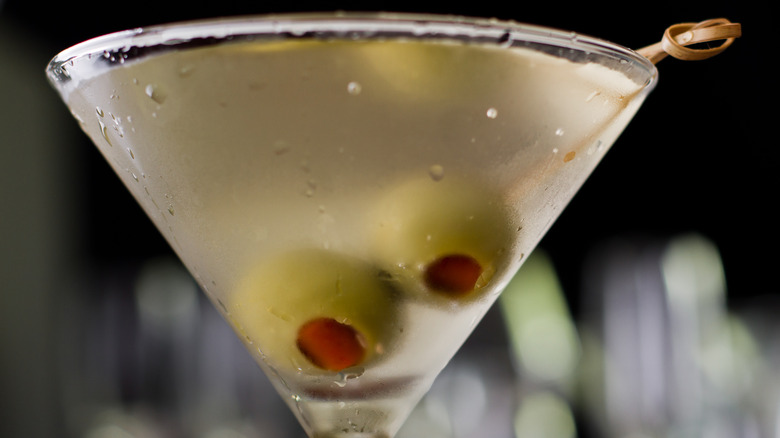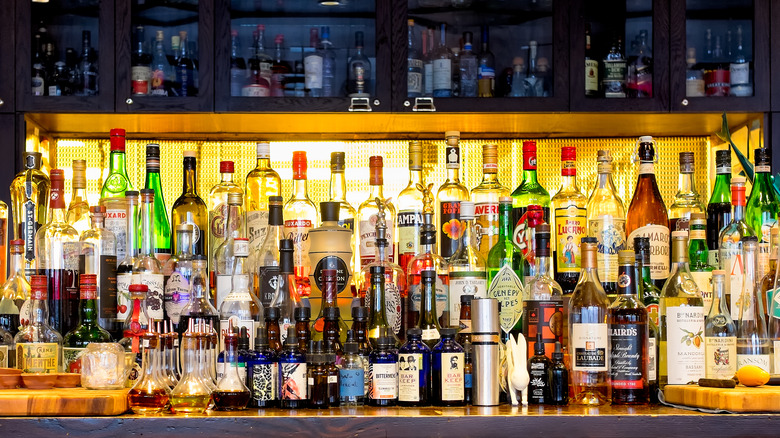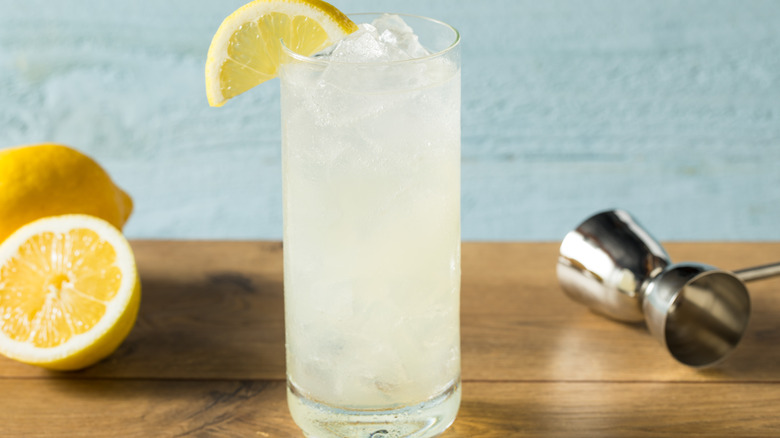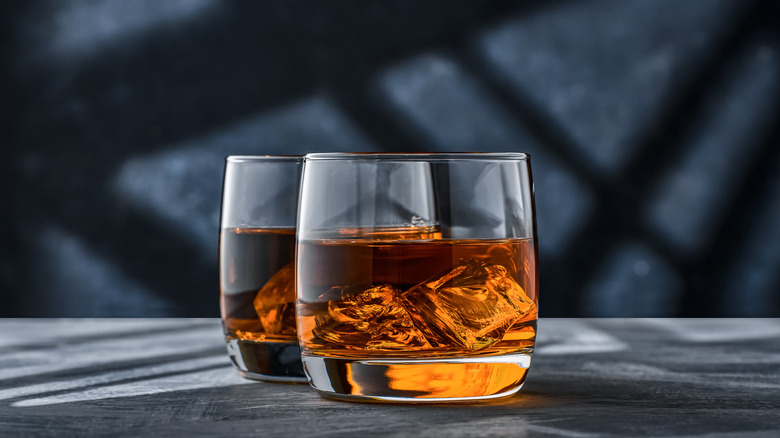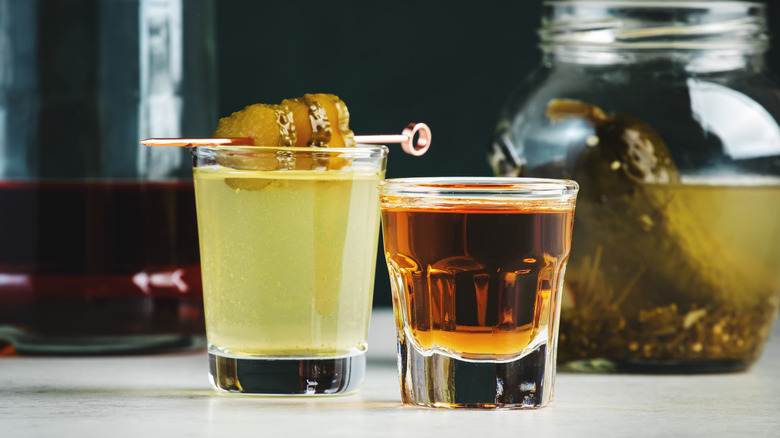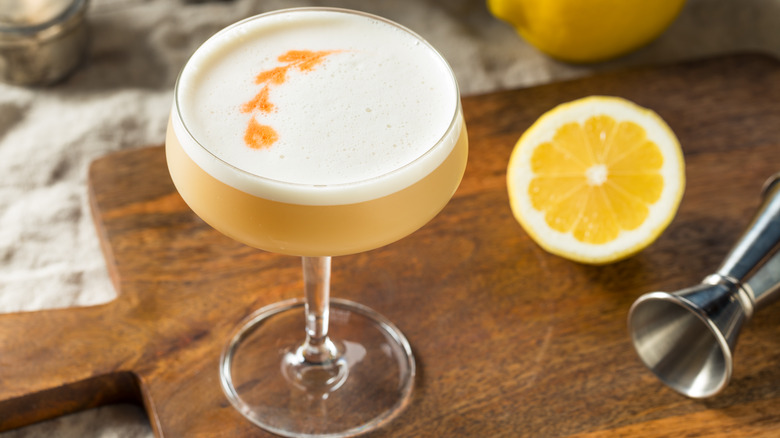Neat, Straight Up, And On The Rocks: How To Order A Cocktail
For the uninitiated bar patron, ordering a drink can be a daunting task. Even if you know exactly what you want, it can be hard for the bartender to understand your request. Rest assured, it's not just you — cocktail ordering is confusing for a lot of people. No bartender wants their customer to be unhappy with their cocktail, and no bar guest wants to be saddled with a drink they don't like. The key to avoiding that situation is communication.
Since drinking establishments can be fast-paced, hectic, and noisy places, it's not always easy to have a nuanced conversation across the two sides of a bar. Luckily, there are some shorthand terms that have become more-or-less standard when ordering drinks — the trick is to know the lingo, what these terms mean, and when to use them. It's also helpful to understand any possible variations, as some of these terms can have more than one meaning.
We've put together a helpful explainer of some of the most common bar ordering terms and how to use them, as well as many terms that often lead to mix-ups. Whether you're a seasoned barfly or a novice cocktail enthusiast, this list should help you learn how to order the perfect cocktail like a pro.
Neat
When you want nothing but alcohol, order your drink neat. Typically this refers to a solo ingredient, not a mixed drink or cocktail. But what it really designates is that the liquid is served unchilled and without ice. No stirring, no shaking, is necessary. All you need is a spirit or liqueur poured from the bottle into the glass.
There is nothing different about the contents of a drink ordered neat or as a shot, but most bars will serve these two orders in different glasses. Order a shot and you'll likely get it in a shot glass. Order it neat and you'll likely receive it in a tumbler, also known as an old fashioned glass. If the spirit you order is on the premium end of the spectrum — such as a Scotch or whiskey — you might get it in what's called a Glencairn glass, which is tulip-shaped. This style of glass is crafted to maximize the aromatic intensity of its contents. Ordering neat is a great way to get to know different types and brands of spirits.
How to order: "I'd like a bourbon, neat." If you're calling for a specific brand, say something like: "I'd like a Maker's Mark, neat."
Up
A drink ordered up will be either stirred or shaken with ice, and then strained and poured. Typically up drinks are served in pre-chilled glasses to keep them cold since they're not served over ice. Many classic cocktails are served up by default, including martinis, Manhattans, and cosmopolitan.
Cocktails ordered up can be poured into many different types of glasses, but they're most commonly served in stemware, either a conical martini glass or a rounded coupe. The stem helps keep the drink cool by giving your hands a way to grab the glass without warming the drink.
How to order: for many cocktails, you don't need to ask for them up, as they will be served that way automatically. But you may want to in case you're not sure, or just to cover your bases. "I'd like a vodka Gimlet, up" is sufficient. You can further specify what glass you'd prefer if you like.
Straight up
Straight up is a tricky phrase in bartending, and one that shouldn't be used without further clarification. That's because it means different things to different people, and it's made up of two words that also mean different things, so if one word gets misheard, you may end up with a very unexpected cocktail in your hand.
The word straight is sometimes used to mean the same thing as neat: room temperature, not served over ice. The word up, as described above, means chilled and strained. The term straight up could mean either one of these.
How to order: since the term is confusing, never just say "straight up" — always make sure you specify what you mean. Generally, if you're ordering a cocktail that's usually served up, the bartender will presume that's what you mean if you say straight up. But if it's a drink that's not so straightforward, make sure to clarify. "I'd like a Tanqueray, straight up," can either mean a pour of Tanqueray gin at room temperature or chilled. So better be specific, such as, "I'd like a Tanqueray — straight up, shaken, and served in a chilled martini glass."
On the rocks or over
A drink served on the rocks is fairly simple: all it means is that it's served on ice. It's somewhat less commonly referred to as over, as in the drink is poured over ice cubes. One complication that this term can bring about regards the ice itself. Many bars, particularly higher-end craft cocktail spots, will have different styles of ice, and each will bring a different character to your drink.
The smaller the ice, the more surface area comes into contact with the alcohol, which leads to faster dilution. Crushed ice will melt the fastest, and large cubes or spheres that take up the biggest volume will dilute your drink at the slowest rate. The choice of ice is largely a matter of personal preference.
How to order: for a single spirit, "I'd like a whiskey on the rocks" or, "I'd like a Jameson on the rocks." If you want to specify ice, "I'd like a vodka over crushed ice," or "I'd like a Negroni on a large cube."
Shaken
If you like your drinks super cold and with lots of dilution, ordering them shaken is the way to get it. As a general bartending rule, certain cocktails are shaken by default, including anything that involves citrus, dairy, or egg whites. Those ingredients need some extra agitation in order to properly integrate with spirits and liqueurs.
But anything can be shaken, including solo spirits. Many cocktails such as martinis, Negronis, and Manhattans are stirred as a rule, so it's always good to specify this method if you prefer a shaken drink. A shaken drink should always be poured into a pre-chilled glass so that it maintains its frosty temperature for as long as possible.
How to order: "I'd like a vodka martini, shaken." You can further specify "extra cold" or "extra shaken" if you like a very icy, very chilled cocktail. This is a great way to avoid confusion.
Stirred
Stirring a cocktail is a way to chill it in a gentle, elegant way. The ice slowly and subtly releases dilution into the drink with every rotation of the bar spoon. This results in a cocktail with a very different texture than one that's been shaken — it'll have a smoother, silkier mouthfeel.
The stirred method generally works best with cocktails that are spirit-driven, as opposed to those that have ingredients like juice or dairy. However, if you prefer the texture of a stirred cocktail, you can ask your bartender to prepare any drink this way. A stirred drink, like a shaken drink, should always be poured into a chilled glass to keep it cool.
How to order: "I'd like a vodka martini, stirred." If not specified, a stirred drink will likely be served up. If you want ice, you can order "a vodka martini, stirred, on the rocks" or "a Negroni, stirred, on a large cube."
Frozen or blended
If a stirred or shaken cocktail is just not cold enough for you, a frozen drink may be the way to go. Not every bar will have a blender in order to create this style of beverage, so keep that in mind.
Generally reserved for fruity and citrusy drinks like margaritas and Daiquiris, frozen (also known as blended) cocktails use high-speed blades to crush and whip ice with the cocktail ingredients so everything is fully integrated. This creates a frosty texture that's liable to give you a brain freeze if you drink it too quickly. But there's nothing quite as refreshing and satisfying on a hot sunny day as an ice-cold frozen cocktail.
How to order: "I'd like a Margarita, frozen" or "I'd like a Margarita, blended." Margaritas, frozen or otherwise, typically come with salt on the rim, so it's always a good idea to specify no salt if you prefer the drink without it.
Dry
Dry is one of those descriptors that means something different to everyone. It's most often used when ordering a martini. A martini may look and seem like an incredibly simple drink. But despite the fact that it only involves two ingredients — gin (or vodka) and dry vermouth — it's deceptively complex. When you order a martini dry, you're letting the bartender know that you want less vermouth in your drink than is typically added.
But for some martini fans, dry means a healthy slug of vermouth. For others, it may mean just a few drops. Because there's no hard and fast rule for what dry actually means when it comes to martinis, it's best to have a ballpark idea of the actual amount you like and communicate it with the bartender as specifically as you can, ideally with a ratio.
The term dry also has a different meaning for other cocktails, in which it means the opposite of sweet. This term can be used with any drink that has simple syrup, sugar, honey, or any other sweet ingredient. In these cases, saying "dry" lets your bartender know you want your cocktail to have less of that ingredient.
How to order: "I'd like a dry gin martini, ten to one" means you want ten parts gin to one part dry vermouth. "I"d like a dry gin Gimlet" means you want less simple syrup in your drink, so it's not as sweet.
Wet
The term wet, as you may have surmised, means the opposite of dry when it comes to cocktails. Whereas a dry martini will have less vermouth than the typical amount, a wet martini will have more. Just as with dry, wet is a somewhat vague term that doesn't refer to a specific amount, so it helps to give your bartender a ratio or approximate amount of how much vermouth you like. Keep in mind that a wet martini will be lower in alcohol than a traditional one, thanks to the higher percentage of vermouth. Gins have a much higher ABV than vermouths.
If you say, "I'd like a gin martini, wet," you will get a healthy dose of vermouth, compared to a standard recipe. "A wet gin martini, 50-50" means your cocktail will be half gin, half vermouth. You probably don't need to add the term wet if you order this style, as the 50-50 is specific enough for the bartender to know exactly how you want your drink.
Perfect
Perfect is yet another term that refers to vermouth, and is typically used when ordering martinis and Manhattans. A traditional martini consists of gin or vodka and dry vermouth, and a classic Manhattan combines whiskey and sweet vermouth.
But instead of keeping the vermouth styles confined to their respective cocktails, you can mix them to make what's known as a perfect cocktail. Splitting the vermouth component of these drinks into equal parts dry and sweet vermouth adds a light herbal quality to a Manhattan, and a deeper, richer flavor to a martini, for extra complexity in each cocktail.
How to order: "I'd like a perfect gin martini" or "I'd like a perfect rye Manhattan" means the bartender will evenly split the normal amount of vermouth called for in each cocktail. You can also specify wet or dry if you want the bartender to add or subtract the total portion of vermouth.
Dirty
Dirty is a term that is most commonly associated with the martini. To make a martini dirty, a bartender will add a splash of olive brine to the drink, which gives it a salty, savory flavor. Other types of liquid can be used to make dirty cocktails — like pickle brine or pepperoncini juice — but olive brine is by far the most common ingredient.
The dirty style doesn't have to be relegated only to martinis, either. Savory drinks like bloody marys are well-suited to the addition of a shot of brine, and pickle juice and whiskey make a surprisingly delicious combination. If you have a palate that gets more excited about salt and umami than sweetness, you might enjoy experimenting with dirty cocktails of all kinds.
How to order: "I'd like a dirty vodka martini" will get you a standard martini with a splash of olive brine. Ask for "an extra dirty vodka martini" if you want more brine added, or a "filthy" martini to go to the absolute limit.
Well
When ordering spirits, mixed drinks, and classic cocktails, if you don't call for a specific bottle, the bartender will typically use what's known as a well spirit. Well spirits are decent but inexpensive brands of basic liquors that are used by default to make drinks for customers who don't have a brand preference. Often you don't need to ask for a well spirit — as long as you don't mention a specific brand, the well bottle will probably be used. But in case you want to be sure, you can ask for the well when you order. There are some bars that may (somewhat unscrupulously) silently upsell you to a more premium brand if you don't mention a preference.
How to order: "I'd like a well vodka and tonic," or "I'd like a well bourbon, neat," or "I'd like a well gin martini." If you're not sure if you want the well spirit, you can always ask the bartender what brand they use in their well, and whether or not they recommend it.
Tall or long
The terms tall and long (which are interchangeable) refer to a drink that's made in glass that's large enough to accommodate a high volume of liquid. This is typically used in ordering drinks made with mixers, like soda, cola, and tonic water. When made in a tall glass (also known as a Collins glass), the extra ice and mixer dilute the taste of the alcohol, compared to the same drink made in a shorter glass with the same measure of spirit.
Don't confuse a tall drink with a stronger drink, and don't be fooled by the weaker taste — a serving of spirit is standardized across drinks no matter how large or small the glass is. If, on the other hand, you prefer a stronger-tasting beverage, you can ask for it to be served short.
How to order: "I'd like a tall gin and tonic," or "I'd like a tall Bacardi and coke."
Double
Ordering a double is fairly self-explanatory: You'll get twice the amount of a standard pour of liquor. This can apply to solo spirits and liqueurs, whether they're ordered neat or on the rocks. It can also apply to mixed drinks, such as a vodka soda, a gin and tonic, or a rum and Coke. In these cases, you'll get double the spirit and less mixer, which will make the drink taste extra strong.
Specialty cocktails shouldn't be ordered as doubles, as the addition of more base spirits will throw off the balance of the carefully constructed flavors. You can try to order the entire drink as a double, but be aware that the bar may not have a glass large enough to accommodate the volume, and a double cocktail will likely get too warm if served up, or too watered down if served on the rocks, due to its size.
How to order: "I'd like a double bourbon, neat," or "I'd like a double whiskey and soda."
Back
A back typically refers to a non-alcoholic liquid that's served alongside an alcoholic beverage. It can be water, a mixer like soda or cola, or juice. A back is basically the same thing as a chaser, but a chaser is typically served with a shot. The term back is more common when it's served with a drink that's sipped. It acts as something of a palate cleanser, helping to mitigate the alcoholic drink's strong taste. A back is sometimes, but not always, complimentary with your spirit or cocktail, depending on what it is. You can order a beer back, but don't expect that to be free of charge, as it's technically another alcoholic beverage.
The pickleback is a popular choice right now, often served alongside whiskey-based drinks. For some reason, the combination of whiskey and pickle brine creates a magical alchemy when consumed together.
How to order: "I'd like a bourbon with a pickleback," or "I'd like a Manhattan with a soda back."
Sour
Sour is a good cocktail term to get to know. It refers to a category of drinks that consist of a sour element, most commonly citrus juice, along with a sweet element and a spirit or liqueur. Not too long ago, the pre-bottled sour mix was the norm in these drinks, but this artificial product has fallen out of favor these days with the rise of the craft cocktail movement. Most bars use fresh citrus juice now. One thing to keep in mind is that many sour recipes utilize egg whites to create a head of frothy foam on top of the drink, so when ordering a sour, it's wise to specify your preference for egg or no egg. You can also specify if you like lemon or lime juice, or a combination of both.
How to order: "I'd like a pisco sour, no egg" or "I'd like a whisky sour with lemon and egg white."
